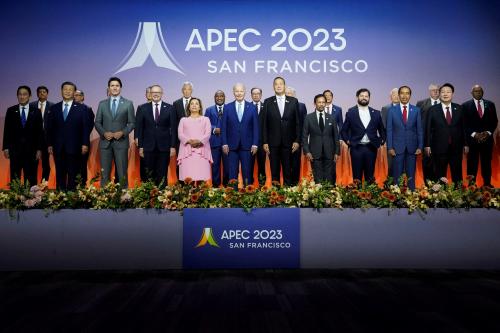Editor’s Note: This post is the first in a new series looking into the inner workings and complex bilateral relationships of the United States, China and India – which contain two-fifths of the world’s population and two-fifths of its GDP.
When Xi Jinping arrived in Gujarat on Wednesday, the world’s two largest nations began a meeting noteworthy in two regards – somewhat in tension with one another.
On the one hand, the meeting symbolized the return of strongmen at the helm of Asia’s giant nations. In 2013 China’s Xi Jinping effectively consolidated power, after a decade of internal divisions in China’s leadership. And in May 2014, Narendra Modi’s electoral landslide produced the first single-party parliamentary majority in India in over thirty years. Both China and India seem willing, again, to experiment with a more top-down, streamlined approach to governing—wiping away decades of creeping decentralization and drift.
That also seems to contradict the noteworthy selection of Gujarat for the meeting. To understand Modi’s vision for India, you must understand it from the “inside out.” Modi’s bottom-up, local economic success in Gujarat will be the model for success in the rest of India – just as it was the engine of Chinese economic growth in the last two decades.
Yet it is also possible that the rise of strongmen and the persistent importance of local governments could be compatible with one another—or to modify F. Scott Fitzgerald’s famous statement, “The test of a first-rate leader is the ability to hold two opposing ideas in mind at the same time and still retain the ability to function.” Xi Jinping and Narendra Modi ostensibly embody powerful centralized leadership, but if they are to accomplish great things for their countries, they will need to effectively channel local government — indeed, even working to foster local innovation and autonomy.
The paradox of power in both India and China is that central governments must selectively give away power, yielding economic freedom to the private sector and political responsibility and accountability to localities. This applies to most complex multilayered systems, particularly ones as massive as India and China.
The fact that both Xi Jinping and Narendra Modi have been local leaders will help. Both men know this. Both know that steering out of an economic skid means getting traction from the power of the private sector—and reducing the role of government in the economy. Both men know that they will have to share power more effectively with massive states and provinces as well as with megacities and other local governments. Indeed, Modi and Xi both used local political autonomy to unleash local economic dynamism. And both are currently in the process of renegotiating the compact that connects them to far-flung states and provinces.
Getting that negotiation right is also important if either leader wants to address a wider range of challenges. Vexing problems such air and water pollution, housing shortages, migrant workers, and endemic corruption all require effective local governments. So do global challenges, such as attracting foreign investment, exporting goods and services, and fighting climate change.
In China’s case, local leaders already have surprising autonomy, contributing significantly to China’s three decades of success. What they lack is accountability to match that autonomy—accountability not only to Beijing but also to local residents and the private sector. Xi’s challenge is close that accountability gap.
China’s local governments have used central resources to build gleaming cities, wide highways, and impressive subway and high-speed train networks. By time Xi took office in early 2013, the goals for that approach to urbanization had evolved, with plans to move nearly 200 million people from countryside to cities by 2022, or about 1.5 million people per month.
That style of urbanization has had a significant downside, of course. It has created mountains of local debt, hundreds of millions of unsatisfied workers, dozens of cities with unbreathable air and undrinkable water, and rampant and intolerable local corruption. China’s next great challenge is to address the various side-effects of urbanization while still growing the economy. Yet none of these problems can be fixed solely by a strong, centralized government. Action—and accountability—must be localized.
In India the opposite is the case. A myriad of elected officials are formally accountable to electorates, but only a few have seized the responsibility to which they are entitled. Modi was one of those few who had done so successfully, and his challenge will be to encourage others to do the same without creating greater fragmentation.
On some national issues, Modi can act swiftly – but only where action does not require new legislation. His parliamentary majority means avoiding the complications of coalition politics when appointing ministers or managing intra-cabinet rivalries. That is a major step forward from previous governments, which were a hodgepodge of ministers from coalition parties.
But streamlining of federal agencies cannot be done by administrative fiat. Where real legislation is required, Modi still will have to come to terms with the upper house of parliament, which represents the enduring authority of states.
Because of that, Modi has hinted that he will solicit state leaders to endorse his initiatives directly. Since the BJP only controls five states, and Congress still controls eleven states, Modi is keen to partner with chief ministers from regional parties, such as J. Jayalalitha in Tamil Nadu, or N Patnaik in Orissa, or Chandrababu Naidu in Andhra Pradesh. In addition to getting them to support national efforts, he also will encourage those leaders to continue to take direct local responsibility.
Mr. Modi and Mr. Xi would be well served to encourage state and provincial officials to work with one another to build deeper ties than can be managed from New Delhi and Beijing. Chinese provinces such as Zhejiang, home of online giant Alibaba, can learn from south Indian states that have effectively managed the world’s software revolution. And Indian manufacturing hubs can learn from Guangdong how to become export giants, while also learning the lessons of runaway urbanization.
For both Mr. Modi and Mr. Xi, local success have been pivotal to their rise. Each man will need to invest locally – and perhaps do so together.
This post is excerpted from the updated paperback edition of
Inside Out, India and China
(Brookings Institution Press, 2014).


Commentary
Power Paradox: Seizing Control to Give It Away
September 18, 2014